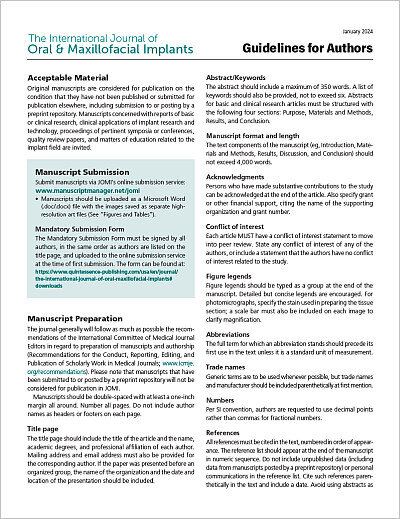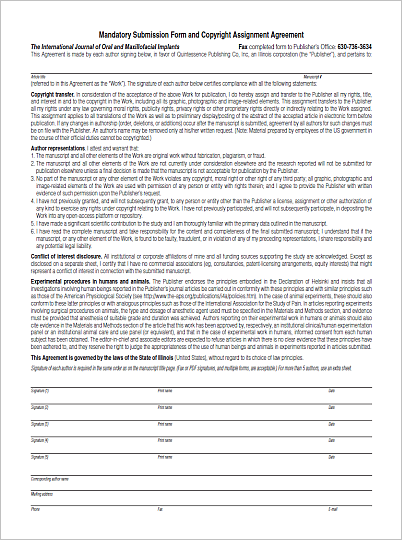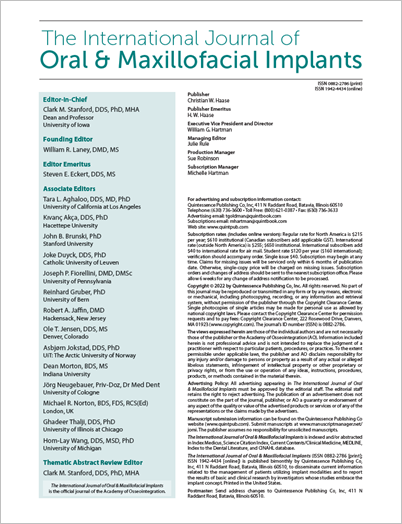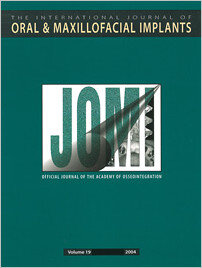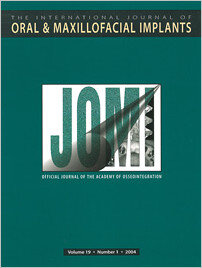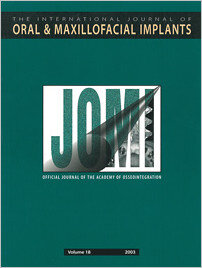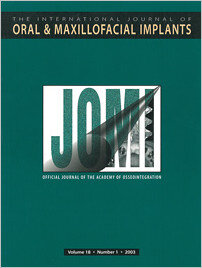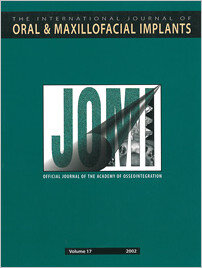Pages 643, Language: EnglishLaney, William R.Pages 645-647, Language: EnglishIrish, Joel D.Archaeological excavations at a Neolithic cemetery near Gebel Ramlah, Egypt yielded, among other finds, a life-size shell carving of a human tooth. Based on its spatulate crown and large conical root, the tooth most closely emulates a maxillary incisor. The crown's lingual and labial surfaces are suggestive of a left central incisor, whereas the occlusal view is more reminiscent of a left lateral incisor. The present report details the tooth's appearance and provides several interpretations concerning its function, including the possibility that it was intended to be a dental implant.
Pages 648-658, Language: EnglishTan, Ban Fui / Tan, Keson B. / Nicholls, Jack I.Purpose: Critical bending moment (CBM), the moment at which the external nonaxial load applied overcomes screw joint preload and causes loss of contact between the mating surfaces of the implant screw joint components, was measured with 2 types of implants and 2 types of abutments.
Materials and Methods: Using 4 test groups of 5 implant-abutment pairs, CBM at the implant-abutment screw joint was measured at 25%, 50%, 75%, and 100% of the manufacturer's recommended torque levels. Regular Platform (RP) Nobel Biocare implants (3.75 mm diameter), Wide Platform (WP) Nobel Biocare implants (5.0 mm diameter), CeraOne abutments, and Multiunit abutments were used. Microstrain was measured as loads were applied to the abutment at various distances from the implant-abutment interface. Strain instrumentation logged the strain data dynamically to determine the point of gap opening. All torque applications and strain measurements were repeated 5 times.
Results: For the CeraOne-RP group, the mean CBMs were 17.09 Ncm, 35.35 Ncm, 45.63 Ncm, and 62.64 Ncm at 25%, 50%, 75%, and 100% of the recommended torque level, respectively. For the CeraOne-WP group, mean CBMs were 28.29 Ncm, 62.97 Ncm, 92.20 Ncm, and 127.41 Ncm; for the Multiunit-RP group, 16.08 Ncm, 21.55 Ncm, 34.12 Ncm, and 39.46 Ncm; and for the Multiunit-WP group, 15.90 Ncm, 32.86 Ncm, 43.29 Ncm, and 61.55 Ncm at the 4 different torque levels. Two-way analysis of variance (ANOVA) (P .001) revealed significant effects for the test groups (F = 2738.2) and torque levels (F = 2969.0).
Discussion: The methodology developed in this study allows confirmation of the gap opening of the screw joint for the test groups and determination of CBM at different torque levels.
Conclusion: CBM was found to differ among abutment systems, implant diameters, and torque levels. The torque levels recommended by the manufacturer should followed to ensure screw joint integrity.
Pages 659-666, Language: EnglishEllingsen, Jan Eirik / Johansson, Carina B. / Wennerberg, Ann / Holmén, AndersPurpose: The purpose of the present study was to investigate whether a fluoride modification of the titanium surface would have an effect on bone response after implantation.
Materials and Methods: Titanium-oxide-blasted titanium implants with and without fluoride modification were investigated in a rabbit tibia model. Quantitative analysis of surface roughness, biomechanical interlocking, and in vivo tissue reactions in rabbit bone at 1 and 3 months after placement were compared.
Results: The fluoride-modified test implants had a slightly smoother surface (Sa: 0.91 ± 0.14 µm) than the unmodified control implants (Sa: 1.12 ± 0.24 µm). Significantly higher removal torque values (85 ± 16 Ncm vs 54 ± 12 Ncm) and shear strength between bone and implants (23 ± 9 N/mm² vs 15 ± 5 N/mm²) were measured for the fluoride-modified implants after 3 months. The histomorphometric evaluations demonstrated higher bone-to-implant contact for test implants at 1 month (35% ± 14% vs 26% ± 8%) and 3 months (39% ± 11% vs 31% ± 6%) after placement.
Discussion: Implant surface modification with fluoride may result in morphologic and physiochemical phenomena that are of significance for the bone response. Another possible explanation for the findings in the present study is that a surface modification changes the surface chemical structures to be more suitable for bone bonding.
Conclusion: Based on the biomechanical and histomorphometric data, the fluoride-modified titanium implants demonstrated a firmer bone anchorage than the unmodified titanium implants. These implants achieved greater bone integration than unmodified titanium implants after a shorter healing time. (More than 50 references.)
Pages 667-678, Language: EnglishSykaras, Nikitas / Woody, Ronald D. / Iacopino, Anthony M. / Triplett, R. Gilbert / Nunn, Martha E.Purpose: To evaluate the effect of rhBMP-2 on implant osseointegration using histomorphometric and radiographic imaging analyses and determine the diagnostic accuracy of periapical radiographs regarding clinical bone-implant contact levels.
Materials and Methods: Hollow-cylinder implants were filled with an absorbable collagen sponge soaked with recombinant human bone morphogenetic protein-2 (rhBMP-2) or left empty and implanted in the mandibles of dogs. Animals were followed for 2, 4, 8, or 12 weeks. At the end of each time interval, the animals were sacrificed and specimens were collected for histomorphometric and radiographic evaluation of the bone-implant contact levels.
Results: Both groups exhibited the same mean histologic bone-implant contact on the outer surface of the implant, except for the 4-week group. The radiographic evaluation of bone-implant contact overestimated the actual osseointegration levels by at least 30%, a significant amount.
Discussion: The osteoinductive and regenerative potential of rhBMP-2 is of clinical benefit in cases where bone augmentation is indicated and improved levels of osseointegration are expected. Radiographic evaluation has been the most widely employed technique in clinical practice for assessing bone levels around dental implants and comparing changes over time. However, there is a limit to the diagnostic accuracy of conventional radiographs when compared to the data obtained by histologic analysis.
Conclusion: Application of rhBMP-2 within the confined boundaries of the hollow chamber of the implant had a limited effect on the osseointegration level along its outer surface, perhaps because of physically restricted diffusion. Radiographic evaluation resulted in the overestimation of bone-implant contact, and poor correlation with the histomorphometric data was found.
Pages 679-686, Language: EnglishPinheiro Carvalho, Valéria Abrantes / de Oliveira Tosello, Darcy / de Castillo Salgado, Miguel Angel / Gomes, Mônica FernandesPurpose: The aim of this work was to evaluate the effectiveness of homogenous demineralized dentin matrix (HDDM) slices in surgical bone defects created in the mandibles of rabbits and occluded with a polytetrafluoroethylene (PTFE) membrane in the promotion of bone growth.
Materials and Methods: Surgical bone defects were created in 36 adult rabbits and divided into 4 groups: bone defect (control), bone defect with PTFE membrane, bone defect with HDDM, and bone defect with both HDDM and a PTFE membrane (HDDM + PTFE). The rabbits were sacrificed after 30, 60, and 90 days, and the bone defects were examined histologically and by histomorphometric analysis (analysis of variance and the Tukey test).
Results: The volume of newly formed bone matrix was significantly greater in the HDDM and HDDM + PTFE groups than in the control and PTFE groups. The discrete inflammatory reaction found in the HDDM and HDDM + PTFE groups did not prevent the osteopromotive activity of the dentin matrix.
Discussion: HDDM slices were biocompatible and were resorbed during the bone remodeling process. They stimulated the newly formed bone until 30 days after implantation.
Conclusion: Bone repair was accelerated in the bone defects treated with HDDM in comparison to the control group.
Pages 687-694, Language: EnglishKeller, John C. / Stewart, Michelle / Roehm, Melissa / Schneider, Galen B.Purpose: Usage of dental implants has become common for the treatment of edentulous patients, but concerns exist over the use of implants in patients where orofacial bone loss occurs. In the present study, the osseointegration of implants in rabbits under osteoporosis-like (OP-like) conditions simulating several clinically relevant conditions is reported.
Materials and Methods: Forty rabbits were divided into 4 groups of 10. Three groups of animals received daily intramuscular injections of glucocorticoids (7.5 mg/kg) for 8 weeks to induce OP-like conditions either before, simultaneous to, or after implant placement.
Results: The injections of glucocorticoids resulted in cortical thinning, irregular trabecular patterns, and impaired extracellular (ECM) matrix formation and mineralization. Although interfacial strength (8.5 ± 1.3 MPa for the control group; 9.3 ± 4.0 to 10.1 ± 4.0 MPa for the experimental groups) was apparently not affected in this limited sample cohort (n = 3 per group), statistically significant decreases (P .05) in implant-bone contact were observed in animals with OP-like conditions (49% ± 10% for the control group; 24% ± 16% to 42% ± 16% for the experimental groups).
Discussion: Histologic features characteristic of OP-like conditions were observed in each experimental group. ECM expression also appeared to be altered and compromised in all animals with OP-like conditions, which may affect long-term biomechanical stability of the implants.
Conclusion: OP-like conditions affect the osseointegration characteristics of implants, but long-term biomechanical stability under forces of mastication is unknown as yet.
Pages 695-702, Language: EnglishNaert, Ignace / Alsaadi, Ghada / van Steenberghe, Daniel / Quirynen, MarcPurpose: This randomized controlled clinical trial aimed to evaluate the efficacy of splinted implants versus unsplinted implants in overdenture therapy over a 10-year period.
Materials and Methods: The study sample comprised 36 completely edentulous patients, 17 men and 19 women (mean age 63.7 years). In each patient, 2 implants (Brånemark System, Nobel Biocare, Göteborg, Sweden) were placed in the interforaminal area. Three to 5 months after placement, they were connected to standard abutments. The patients were then rehabilitated with ball-retained overdentures, magnet-retained overdentures, or bar-retained overdentures (the control group). Patients were followed for 4, 12, 60, and 120 months post-abutment connection. Group means as well as linear regression models were fitted with attachment type and time as classification variables and corrected for simultaneous testing (Tukey).
Results: After 10 years, 9 patients had died and 1 was severely ill. Over 10 years, no implants failed. Mean Plaque Index, Bleeding Index, change in attachment level, Periotest values, and marginal bone level at the end of the follow-up period were not significantly different among the groups.
Discussion: The annual marginal bone loss, excluding the first months of remodeling, was comparable with that found around healthy natural teeth.
Conclusion: The fact that no implants failed and that overall marginal bone loss after the first year of bone remodeling was limited suggested that implants in a 2-implant mandibular overdenture concept have an excellent prognosis in this patient population, irrespective of the attachment system used.
Pages 703-709, Language: EnglishVigolo, Paolo / Givani, Andrea / Majzoub, Zeina / Cordioli, GiampieroPurpose: Placement of small-diameter implants often provides a solution to space-related problems in implant restoration. This 7-year retrospective study presents results from 192 small-diameter implants placed in 165 patients from 1992 to 1996.
Materials and Methods: The dental records of each patient were reviewed. The implants, which were either 2.9 mm or 3.25 mm in diameter, were placed by 2 different surgeons. All prosthetic appliances were fabricated by the same prosthodontist. Ninety-four implants supported single-tooth cemented restorations; the remaining 98 implants supported cemented or screw-retained partial prostheses.
Results: The total implant survival rate was 95.3%. Four implants were lost at second-stage surgery, and 5 more were lost after loading.
Discussion: Small-diameter implants demonstrated a survival rate similar to those reported in previous studies of standard-size implants.
Conclusions: The results suggest that small-diameter implants can be successfully included in implant treatment. They may be preferable in cases where space is limited.
Pages 710-715, Language: EnglishKrennmair, Gerald / Waldenberger, OthmarPurpose: To evaluate wide-diameter (ie, 5.5-mm-wide) Frialit-2 implants used for several forms of prosthetic rehabilitation.
Materials and Methods: In this retrospective study, 121 wide implants (74 maxillary, 47 mandibular) were placed in 114 patients (61 female, 53 male, mean age 37.2 ± 14.9 years). Thirty-six single-tooth restorations, 63 fixed partial dentures (68 implants), 6 removable overdentures (7 implants), and 3 fixed complete dentures (8 implants) were placed. Eighty-seven were placed in the molar regions. The follow-up period for the implants was 12 to 114 months (mean 41.8 ± 18.5 months). Peri-implant bone loss, pocket depth, Plaque Index values, Bleeding Index values, and Periotest values were evaluated.
Results: Overall, 2 maxillary implants were lost, for a cumulative survival rate of 98.3% (97.3% in the maxilla; 100% in the mandible). Mean peri-implant pocket depth (3.4 ± 1.1 mm), bone resorption (1.4 ± 1.2 mm), Periotest values (-4.3 ± 3.1) as well as the Plaque Index and Bleeding Index (grades of 0 in 80% of cases) indicated acceptable results.
Discussion: The high survival rate may be attributed to avoidance of the use of short wide-diameter implants, and the primary intention to place wide-diameter implants. Preference of the molar region was a consequence of the peri-implant bone situation in the premolar region, which was frequently inadequate for a 5.5-mm implant.
Conclusions: The use of wide-diameter implants can be a viable treatment option and may provide benefits in posterior regions for long-term maintenance of various implant-supported prosthetic rehabilitations. Some anatomic and prosthodontic limitations for the use of wide implants were identified.
Pages 716-720, Language: EnglishSchlegel, Karl Andreas / Schultze-Mosgau, Stefan / Eitner, Stephan / Wiltfang, Joerg / Rupprecht, StephanKarl Andreas Schlegel, MD, DDS/Stefan Schultze-Mosgau, PhD, MD, DDS/Stefan Eitner, DDS/Joerg Wiltfang, PhD, MD, DDS/Stephan Rupprecht, MD, DDSPurpose: Epithetic solutions in the maxillofacial region are indicated if plastic surgery reconstruction is not a valid option for an extensive defect. The purpose of this study was to examine whether the extraoral implants used provided sufficient retention to be used as anchoring aids.
Materials and Methods: Between November 1999 and September 2002, 33 identical modified Ankylos implants for extraoral anchorage were placed in 10 patients for the fixation of various epitheses in the midfacial (eye, nose) and ear regions in the course of a clinical trial.
Results: Over a follow-up period of 2 to 34 months, all implants remained osseointegrated (as confirmed radiographically), and the implants and epithetic restorations were clinically stable.
Discussion: The results demonstrated that the lasting retention of maxillofacial epitheses provided by implants assures patients that their epitheses are securely fixed.
Conclusion: The demonstrated extraoral implant system not only achieved sufficient osseointegration but also showed good clinical handling and easy fixation possibilities for epithetic anchorage.
Pages 721-730, Language: EnglishJaffin, Robert A. / Kumar, Akshay / Berman, Charles L.Purpose: The purpose of this article was to determine whether clinical success can be achieved with immediate loading in the completely edentulous maxilla with endosseous screw-type implants.
Materials and Methods: The study sample consisted of 34 patients who were edentulous or about to lose all remaining maxillary teeth. The patients underwent an extensive presurgical and prosthetic workup to determine whether they qualified for the study. Sufficient osseous structure to place 6 to 8 implants with a minimum length of 8 mm was required. Provisional prostheses were fabricated either chairside on the day of implant placement or in a laboratory from an impression. The abutments and temporary restorations were placed 48 to 72 hours postsurgery.
Results: A total of 236 implants were placed in 34 patients. Sixteen implants were lost in 11 patients; thus the survival rate was 93%. All patients subsequently received definitive maxillary restorations.
Discussion: The major cause of implant failure appeared to be micromotion during healing. This was the result of either a non-passively fitting restoration or noncompliance (eg, eating chewing hard foods before the implants had integrated).
Conclusions: This clinical report suggests that immediate loading of implant-supported restorations in the completely edentulous maxilla was a viable treatment alternative for this patient population.
Pages 731-734, Language: EnglishWorthington, PhilipThis article concerns the problem of nerve damage associated with implant placement in the posterior mandible. The causes are discussed, with particular emphasis on intrusion of the drill or implant into the nerve canal. Recommendations are made to help the practitioner avoid this too-common complication.
Pages 735-742, Language: EnglishStegaroiu, Roxana / Khraisat, Ameen / Nomura, Shuichi / Miyakawa, OsamuPurpose: This investigation was concerned with the effect of 3 superstructure materials on the strain around an implant under static and nonimpact dynamic loading.
Materials and Methods: Five highly filled composite resin-veneered crown analogs, 5 autopolymerized acrylic resin-veneered crown analogs, and 5 gold-alloy full cast crown analogs were prepared. The resin veneers were applied to gold-alloy frameworks. These crown analogs were prepared to fit an ITI implant-abutment assembly, which was screwed into a block of acrylic resin to simulate implantation in bone. The crown analogs were successively placed on the abutment, and a lateral load of 100 N was applied to the superstructure by a lever-type testing machine. Strains were recorded under static and dynamic loading by a 2-mm-long strain gauge bonded to the surface of the bone simulant tangential to the implant. The dynamic load simulated masticatory cycles (75 strokes/min).
Results: Although the strain values differed significantly between the static and dynamic loading (P .05), there was no significant difference among the superstructure materials under either loading condition (P > .05).
Discussion: These findings are in agreement with in vivo measurements, thus suggesting that cyclic rather than impact loading should be used in the investigation of occlusal material behavior under functional loading.
Conclusion: Under static and nonimpact dynamic loading, the 3 superstructure materials tested (highly filled composite resin, acrylic resin, and gold alloy) had the same influence on the strain transmitted to a bone simulant that surrounded a single implant.
Pages 743-748, Language: EnglishCehreli, Murat Cavit / Akca, Kývanc / Tönük, ErginPurpose: The objective of this study was to compare torques applied by new and used manual torque devices for Morse-taper implants. Material and Methods: Fifteen ITI manual torque devices were tested. Those in group 1 (n = 5) were new (ie, never used), those in group 2 (n = 5) had been used 50 to 200 times, and those in group 3 (n = 5) had been used 500 to 1,000 times. The torques applied by each device were measured for 35 Ncm and 15 Ncm targets in an experimental setup by a custom-made wrench with strain gauges connected to a data acquisition system. The strain-gauge signals were simultaneously delivered to a computer at a sample rate of 10,000 Hz and converted to torque units.
Results: New devices applied higher torques than used devices for the 35-Ncm torque target (P .05). The torques applied by group 3 devices were approximately 1.5 Ncm lower than those of other groups for the 35-Ncm target and approximately 1 Ncm lower for the 15-Ncm target. Discussion and
Conclusion: ITI manual torque devices deliver consistent torque output, although a slight decrease occurs as a consequence of clinical use.
Pages 749-752, Language: EnglishMurata, Tomoyuki / Yamashita, Yoshihiro / Kurokawa, Hideo / Takahashi, TetsuTreatment of mandibular fracture in senior citizens with severely resorbed edentulous mandibles is extremely difficult. Such treatment must achieve successful osteosynthesis and restore functional mastication. A severely resorbed (Class V) mandible was successfully reconstructed with an autogenous bone graft on the inferior border of the mandible and a titanium mesh plate after a failed attempt to fix the fracture. After the placement of endosseous implants in the mandible, the patient was rehabilitated with an overdenture to restore masticatory function.
Pages 753-757, Language: EnglishGellrich, Nils-Claudius / Suarez-Cunqueiro, Maria Mercedes / Schön, Ralf / Hoffmann, Mark / Schramm, AlexanderThis clinical report presents a modified distraction technique to achieve height in the vector of distraction. The success of distraction osteogenesis depends on both biologic and biomechanical factors. The focus in this case is on correcting the direction of distraction; incorrect distraction direction is a frequent complication associated with distraction osteogenesis in the mandible. A 21-year-old man presented with a 10-mm vertical bone defect in the anterior mandible caused by facial trauma. The treatment chosen was distraction osteogenesis. After osteotomizing a bone segment and slitting the lingual periosteum, the bone segment was advanced anteriorly 4 mm and an extra-alveolar distraction device was applied. This approach allows the distraction device to be placed vertically, thus preventing lingual shift. The newly created alveolar ridge fully met prosthodontic requirements for a predictable outcome.
Pages 758-762, Language: EnglishHerford, Alan S. / Audia, FrancoDistraction osteogenesis is a predictable method for restoring missing tissue prior to implant placement. However, pull from the soft tissue can alter the desired direction of the distraction. This article describes and illustrates techniques that are useful for maintaining the desired vector during alveolar distraction osteogenesis. These methods can prevent the need for further intervention and allow for ideal placement of endosseous dental implants without compromising results.




